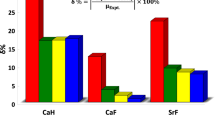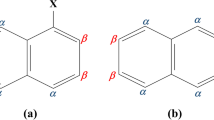Abstract
The geometric and electronic structures, energy stability, and normal mode frequencies of molecules and ions of oxo heme derivatives Heme=O0,±, Heme-O-Heme0,±, Heme-OO0,±, and Heme-OO-Heme0,± (Heme=FeC34H32N4O4) in the states of different multiplicity have been calculated by the density functional theory B3LYP method with several basis sets. Energetically preferred states have been determined, and the energies of different channels of their decomposition with dissociation of the Fe-O and O-O bonds have been estimated. The relative energies of superoxide and peroxide isomers of the dioxygenyl complexes Heme-OO0,± and Heme-OO-Heme0,± have been estimated. For the double-decker Heme-OO-Heme0,± complexes, local minima (intermediates) have been found, which correspond to the structures containing rhombic Fe(μ-O)2Fe moieties with the iron atoms linked by two covalent oxygen bridges Fe-O-Fe. The trends in the behavior of the equilibrium geometric parameters, vibrational frequencies, and spin density distribution between the Fe and O atoms and the porphyrin ring of oxohemes have been analyzed as a function of the electronic state multiplicity and the external charge of the complex.
Similar content being viewed by others
References
Handbook of Porphyrin Science, Ed, by K. M. Kadish, K. M. Smith, and R. Guillard (World Science, New York, 2011).
K. Kalyanasundaram, Photochemistry of Polypyridine and Porphyrin Complexes (Academic, London, 1992).
Electrospray Ionization Mass Spectrometry, Ed. by R. B. Cole (Wiley, New York, 1997).
S. Nonose, H. Tanaka, N. Okai, et al., Eur. Phys. J. D 20, 619 (2002).
O. P. Charkin, N. M. Klimenko, T. P. Nguyen, et al., Russ. J. Inorg. Chem. 50, 1398 (2005).
O. P. Charkin, N. Klimenko, T. P. Nguyen, et al., Chem. Phys. Lett. 415, 362 (2005).
O. P. Charkin, N. M. Klimenko, T. P. Nguyen, et al., Russ. J. Inorg. Chem. 51, 1613 (2006).
O. P. Charkin, N. Klimenko, D. Charkin, et al., J. Phys. Chem. A 111, 362 (2007).
O. P. Charkin, N. M. Klimenko, and D. O. Charkin, Russ. J. Inorg. Chem. 52, 1088 (2007).
O. P. Charkin, N. M. Klimenko, D. O. Charkin, et al., Russ. J. Inorg. Chem. 51, 89 (2006).
M. J. Frish et al., GAUSSIAN 03, Revision B.03, Gaussian, Inc., Pittsburgh, PA, 2003.
A. D. Becke, J. Chem. Phys. 98, 5648 (1993).
C. Lee, W. Yang, and R. G. Parr, Phys. Rev. B 37, 785 (1988).
A. Ghosh, in The Porphyrin Handbook, Ed. by K. M. Kadish, K. M. Smith, and R. Guillard (Academic, San Diego, 2000), Vol. 7, Sect. 47.
C. Lecomte, M.-M. Rohmer, and M. Benard, in The Porphyrin Handbook, Ed. by K. M. Kadish, K. M. Smith, and R. Guillard (Academic, San Diego, 2000), Vol. 7, Sect. 48.
O. P. Charkin, A. V. Makarov, and N. M. Klimenko, Russ. J. Inorg. Chem. 53, 718 (2008).
K. E. Riley and K. M. Merz, J. Phys. Chem. A 111, 6044 (2007).
S. Pagola, P. W. Stephens, D. S. Bohle, et al., Nature 404, 307 (2000).
Computational Inorganic and Bioinorganic Chemistry, Ed. by E. T. Solomon, R. A. Scott, and R. B. King (Wiley, New York, 2009).
D. A. Scherils, V. Coccocioni, P. Sit, and N. J. Mazzari, J. Phys. Chem. B 111, 7384 (2007).
M. P. Johansen and D. Sundholm, J. Chem. Phys. 120, 3229 (2004).
H. Chen, W. Lai, and S. Shaik, J. Phys. Chem. B 115, 1727.
S. Shaik and H. Chen, J. Biol. Inorg. Chem 16, 841 (2011).
P. E. M. Siegbahn, J. Phys. Chem. 97, 9096 (1993).
A. Ghosh, J. Almlof, and L. Que, Angew. Chem. Int. Ed. Engl. 35, 770 (1996).
K. Weighardt, Angew. Chem. Int. Ed. Engl. 28, 1153 (1989).
G. Xue, R. De Hont, E. Muenck, and L. Que, Nature Chem. 2, 400 (2009).
Author information
Authors and Affiliations
Corresponding author
Additional information
Original Russian Text © O.P. Charkin, 2013, published in Zhurnal Neorganicheskoi Khimii, 2013, Vol. 58, No. 3, pp. 348–359.
Rights and permissions
About this article
Cite this article
Charkin, O.P. Theoretical study of the structure and stability of oxo heme derivatives. Russ. J. Inorg. Chem. 58, 300–310 (2013). https://doi.org/10.1134/S0036023613030042
Received:
Published:
Issue Date:
DOI: https://doi.org/10.1134/S0036023613030042




